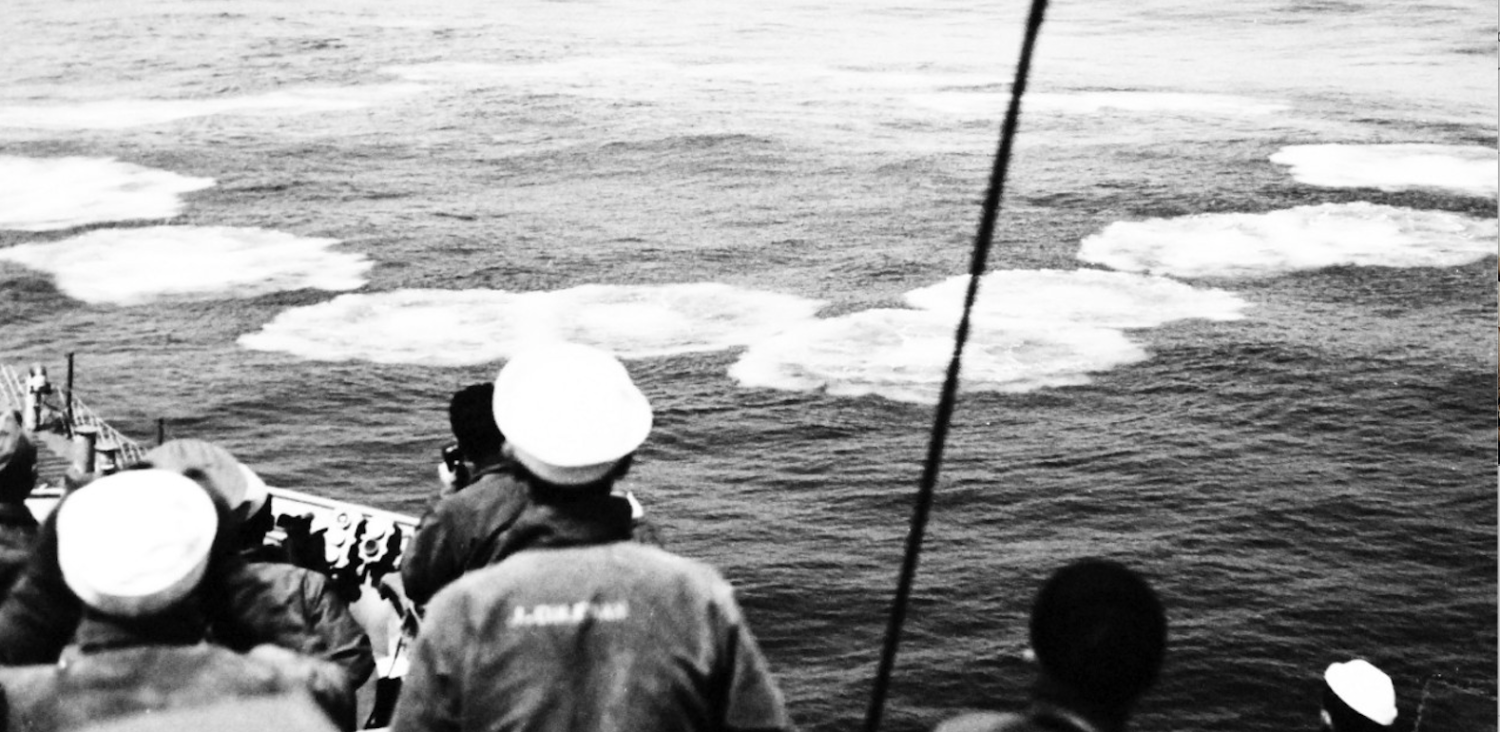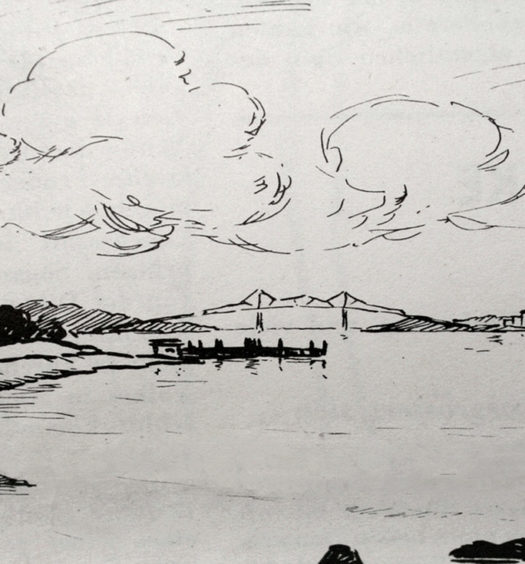[This is the third in a series of four articles honoring the 75th anniversary of the Battle of Point Judith. This third article is based on part of a chapter written by the author in the book World War II Rhode Island (History Press, 2017)]
The first article in this series of four described the tragic sinking of the U.S. merchant vessel Black Point, with the loss of eleven sailors and one Navy guard, in the early afternoon of May 5, 1945 Thirty-four crew members were rescued. Air-sea rescue boats sent from Quonset Point picked up fifteen survivors, landing them at Newport. Coast Guard boats took in the remaining nineteen survivors, taking them to the nearby Point Judith Coast Guard Station. Fifteen of the thirty-four survivors were taken to the U.S. Naval Hospital at Newport.
One of the rescuing ships, the Yugoslav freighter SS Kamen, radioed a report of the torpedoing. At a command post at Point Judith, part of Fort Greene, Boatswain’s Mate Joe Burbine, on watch at the time, had Black Point in view in his binoculars just as he heard a muffled explosion and watched it stagger to a halt. He immediately radioed in the incident, as well as alerted gunners manning six-inch artillery pieces nearby.
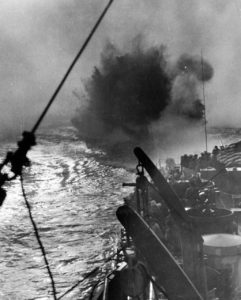
A depth charge seeking out U-853 raises a geyser off the stern of the Coast Guard frigate USS Moberly off Point Judith, Rhode Island, the morning of May 6, 1945 (National Archives)
One of the messages was picked up by the 1st Naval District Headquarters in Boston, which immediately alerted the U.S. Navy’s Eastern Sea Frontier Headquarters in New York, which coordinated the war against German submarines. Staff at the Eastern Sea Frontier started to assemble a search and destroy mission.
At the time all of the destroyers operating out of Newport were on missions at sea and none were nearby. Fortunately for the Americans, three antisubmarine warfare escorts from U.S. Navy Task Force 60.7 were then thirty miles to the southeast, steaming for Boston, after having just escorted an 80-ship convoy from North Africa safely to New York City. They were the destroyer escorts USS Atherton and USS Amick, and the Coast Guard patrol frigate USS Moberly.
Lieutenant Commander L. B. Tollaksen, commanding officer of Moberly, was the senior officer closest to Rhode Island Sound. Tollaksen’s superior, Commannder F. C. McCune, was on the destroyer escort USS Ericsson, by then far ahead in the western end of the Cape Cod Canal. Tollaksen ordered Atherton, Amick, and Moberly to change course and steam at full speed toward the site of Black Point’s sinking. Still, it would take them one-and-one-half hours to arrive there.
Meanwhile, Lieutenant Frömsdorf decided not to surface his submarine and try to speed away from the scene, probably out of fear that he was near strong naval bases that could quickly react and begin searching for U-853 by air and sea. But by staying submerged, the German skipper could only go at slow speeds as he headed out to the sea off Block Island. He was also stuck in relatively shallow water.
Klara Marie Sommers, wife of the first commander of U-853, in 1974 wrote the following about the situation in which Lieutenant Frömsdorf now found himself:
Frömsdorf was very young and ambitious when he became commander after my husband was wounded, and my husband asked him again and again not to act frivolous, for he knew, the end of the war was near and he hoped so much, that all the fine fellows of the crew could survive. He often . . . told me that he never had attacked a ship in such a situation . . . with such little water under the keel and so near the coast.
Klara Sommers further recalled her husband saying to her, “U-853 was lost from the beginning” due to Frömsdorf’s errors in judgement.
Navy officers figured that U-853 might seek shelter in the East Ground, a steeply rising shoal that could allow a submarine to lie alongside it and perhaps escape detection by sonar. There was also a shipwreck in the area, which it was thought the German U-boat commander might use to try to further confuse sonar operators. Tollaksen ordered a search across this area and back. He was hoping to get lucky and locate the enemy submarine.
Arriving in the East Ground about 7:30 p.m., Atherton, Moberly and Amick formed a patrol line abreast and commenced their methodical search for the enemy submarine, using their sonar systems. The search plan worked. At 8:14 p.m., sonar men on Atherton located the submarine, about five miles east of Grove Point on Block Island.
Atherton’s commander, Lieutenant Lewis Iselin, ordered his destroyer to drop thirteen magnetic depth charges, each the size of a large trashcan and containing hundreds of pounds of high explosives. One of them exploded with a powerful concussion, but it could not be determined if it hit the submarine or an old wreck on the ocean floor.
Iselin ordered a second attack with hedgehogs, which were rows of up to 24 projectiles fired at once that detonated only on contact, and thus interfered with sonar less than depth charges. But hedgehogs could explode on the hard sea floor. Atherton lost contact with the U-boat, probably as a result of the depth charge explosions interfering with its sonar. By this time, Commander McCune had arrived on the destroyer Ericcson and assumed overall command.
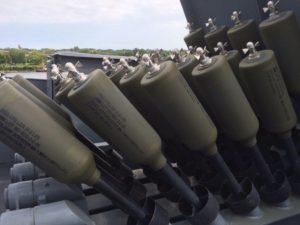
These are so-called hedgehogs, the type of projectile weapon most-often launched by the destroyer escort USS Atherton and frigate USS Moberly against U-853. The photograph was taken by the author in 2018 while touring the destroyer escort USS Slater, anchored on the Hudson River in Albany, New York. It is worth a visit and nearby is Philip Schuyler’s historic home where Alexander Hamilton was married. (Christian McBurney)
Reinforcements arrived, including the destroyers Barney, Breckinridge, Blakeley, and Semmes, the frigate Newport, the corvettes Action and Restless, and PT boats from Melville. McCune ordered them to maintain a barrier patrol around the search site, to guard against the U-boat slipping away to the open sea.
McCune ordered Atherton to search to the north and Moberly to the south. At 11:37 p.m. Atherton’s sonar relocated U-853 lying still at a depth of about 109 feet and some 4,000 yards east of its previous position. The destroyer attacked with more hedgehogs, causing “Large quantities of oil, life jackets, pieces of wood, and other debris, and air bubbles, coming to the surface.” Knowing that shooting debris out of torpedo tubes was a ploy skippers often used to feign death, the attacks continued.
After renewing its attack, Moberly’s sonar man reported, incredibly, that U-853 was moving again. The submarine’s commander, Lieutenant Frömsdorf, was steering to the south at a speed of four to five knots. McCune ordered another attack by both Atherton and Moberly, after which it was determined that the submarine was still moving, but at a reduced speed of two or three knots.
The damaged U-boat could have surfaced to fire its last torpedoes and go down fighting, or even to surrender. But Frömsdorf decided to stick with his original plan and continued to stay submerged. It was the young officer’s final mistake. Meanwhile, the crew must have suffered horribly as it awaited more attacks in the fetid air of the doomed submarine.
Both Moberly and Atherton dropped more depth charges. At about 12:44 a.m. on May 6, Moberly’s spotters saw bubbles, oil and a life jacket. Those on Atherton recovered a pillow, a life jacket, and a small wooden flagstaff.

About 18 hedgehogs fired by the Coast Guard frigate Moberly land in the water in a circular pattern around the ill-fated U-853 the morning of May 6, 1945 (National Archives)
Kenneth Homberger, on board Atherton, recalled many years afterwards, “We always played tag out there with those subs, but we never really knew if we nailed one of them. This time we knew.” He added, ‘‘We had a crackerjack sonar man. He would call out the bearings, and the skipper would maneuver the ship.’’ Homberger further recalled, ‘‘We finally sank that baby about midnight. I was manning one of the search lights. We saw a long line of bubbles coming up. Then there was oil and debris.’’
At 1:14 a.m., Atherton informed headquarters that the submarine was destroyed. Nevertheless, the complete destruction of U-853 was not accepted by headquarters in Boston, and so McCune resumed his attack. The remorseless assault continued through the night, with both depth charges and hedgehogs. Atherton’s Commander Iselin recalled, “There was no doubt that by this time we knew we had it but it seemed everyone wanted to get into the act. I don’t think there is a hull that took a bigger beating during the war.”
After daybreak, a remarkable sight appeared on the horizon. Two Navy blimps, K-16 and K-58, from the Naval Air Station at Lakehurst, New Jersey, arrived and immediately located oil slicks and marked suspected locations with smoke and dye markers. Using MAD radar technology developed in part at Quonset Point, their operators found a stationary target underwater.
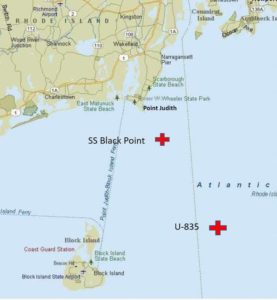
Map showing the locations of the sinkings of Black Point on May 5, 1945, and U-853 a day later. The commander of the German submarine tried to escape south to the open sea, but was thwarted by U.S. Navy and U.S. Coast Guard war ships (Varoujan Karentz)
At about 5:30 a.m., Moberly fired off more hedgehogs. More debris rose to the surface, this time “German escape lungs and life jackets, several life rafts, abandon-ship kits, and an officer’s cap which was later judged to belong to the submarine’s skipper.”
Finally, the blimps dropped sonar devices on the sea above the submarine. Sonar operators reported hearing what they described as “a rhythmic hammering on a metal surface which was interrupted periodically.” Perhaps it was made by a surviving German sailor hoping for rescue.
Moberly, and then Ericcson, continued the attacks on the helpless German submarine. The blimp K-16 also got in on the act, firing 7.2 inch rocket bombs.
The attack ended at 12:07 p.m. on May 6, when Commander McCune at last convinced headquarters in Boston that U-853 had been destroyed. Eastern Sea Frontier in New York ordered the attacks to cease. It is likely the submarine was sunk sometime between midnight and 5 a.m. on May 6. Both Atherton and Moberly were given credit for the kill.
The attackers had unleashed against U-853 264 hedgehogs and 195 depth charges, as well as 6 rocket bombs fired by the blimps. The German submarine had no survivors—its entire fifty-five men crew was killed, probably from a combination of concussions caused by explosions, suffocation and drowning.
Later on May 6, a diver from the submarine rescue vessel USS Penguin, arrived from New London, found the wreck of U-853 in 130 feet of water. He landed on the conning tower and reported that the submarine was lying on its side with its hull split open and with bodies strewn about inside. He saw only two direct hits. Navy divers attempted to enter the wreck to recover the submarine commander’s submarine’s logs and other confidential documents, but failed.
The sinking of U-853 is sometimes said to be the last U-boat sunk by the U.S. Navy in the Battle of the Atlantic, but it was probably the second-to-last. The destroyer escort Farquhar sunk U-881 well off the coast of northeast coast of Nova Scotia at about 5:30 a.m. on May 6, making it likely the last sinking of a U-boat by the U.S. Navy.
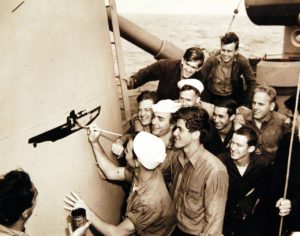
Elated crewmen aboard USS Moberly gather around to watch the final touches of a drawing indicating that the Coast Guard frigate was credited with sinking a U-boat (the Navy’s USS Atherton was also jointly credited with the kill) (National Archives)
May 6, 1945, was far from the end of U-853’s saga. Efforts to reach the entombed men and raise the submarine will be detailed in the fourth and final installment of this series. What happened to the corpse of German submariner Herbert Hoffman?
[Banner image: About 18 hedgehogs fired by the Coast Guard frigate Moberly land in the water in a circular pattern around the ill-fated U-853 the morning of May 6, 1945 (National Archives)]
Bibliography
Books
Kemp, Paul. U-Boats Destroyed: German Submarine Losses in the World Wars. Annapolis, MD: Naval Institute Press, 1997.
Offley, Ed. The Burning Shore, How Hitler’s U-Boats Brought War to America. New York: Basic Books, 2014.
Palmer, Captain Bill. The Last Battle of the Atlantic, The Sinking of the U-853 (Wallingford, CT: Thunderfish Video and Publications, 2012).
Schroder, Walter K. Defenses of Narragansett Bay in World War II. Providence: Rhode Island Publications Society, 1980.
Periodicals
Arnold, David. “The Final Hours of the U-853.” The Boston Globe Magazine, May 5, 1985 (summarizing letters from Guenther Kuhnke and Helga Deisting).
Boston Globe. “39 Saved, One Missing after Sub Scores Three Hits Close Off L.I. Shore,” January 15, 1942.
Carbone, Gerald M. “’They Were All Somebody’s Sons.’” Providence Journal, May 6, 1995.
Lynch, Adam. “Kill and Be Killed? The U-853 Mystery.” Naval History Magazine 22, no. 3 (June 2008).
Tollaksen, D. M.. “Last Chapter for U-853.” U.S. Naval Institute Proceedings, vol. 86, no. 12 (December 1960), pp. 82-89.
Original Sources
Albin, Jr., G.W. Letter to Chaplain J.P. Gallagher, undated (probably around 1960). U-853 File, Naval War College Archives.
Associated Press photograph of captain’s cap and other items salvaged from U-853. May 16, 1945, id. no. 4505160152 (at www.apimages.com (search for U-853) (http://www.apimages.com/metadata/Index/Watchf-Associated-Press-Domestic-News-APHS21292-/420be48d96f74b6796b49d52766a844e/6/0)
Coward, Lieutenant Barbara. Memorandum dated May 14, 1945. U-853 file, UD-09D 19, No. 26870453, U.S. Department of Navy files, National Archives, Silver Spring, MD.
Letter from Klara Marie Sommers to Thomas Reach, March 20, 1974, reproduced in Captain Bill Palmer, The Last Battle of the Atlantic, The Sinking of the U-853 (Wallingford, CT: Thunderfish Video and Publications, 2012), page 53. Klara misspelled Reach’s name, spelling it Roach.
Other
DiCarpio, Ralph. “The Battle of Point Judith.” Destroyer Escort Sailors Association. Online article at http://www.desausa.org/Stories/battle_of_point_judith_2.htm.
“German U-Boat Casualties in World War Two.” Online article on the Navy History and Heritage Command’s website. At https://www.history.navy.mil/content/history/nhhc/research/library/online-reading-room/title-list-alphabetically/u/united-states-submarine-losses/german-u-boat-casualties-in-world-war-two.html
Klepper, Jim. “Sinking of German Submarine U-881.” Destroyer Escort Sailors Association. On line article at https://www.desausa.org/images4/uss_farquhar_de_139_u_881.htm.
World Public Library. “German Submarine U-853.” www.worldlibrary.org/articles/German_submarine_U-853.

